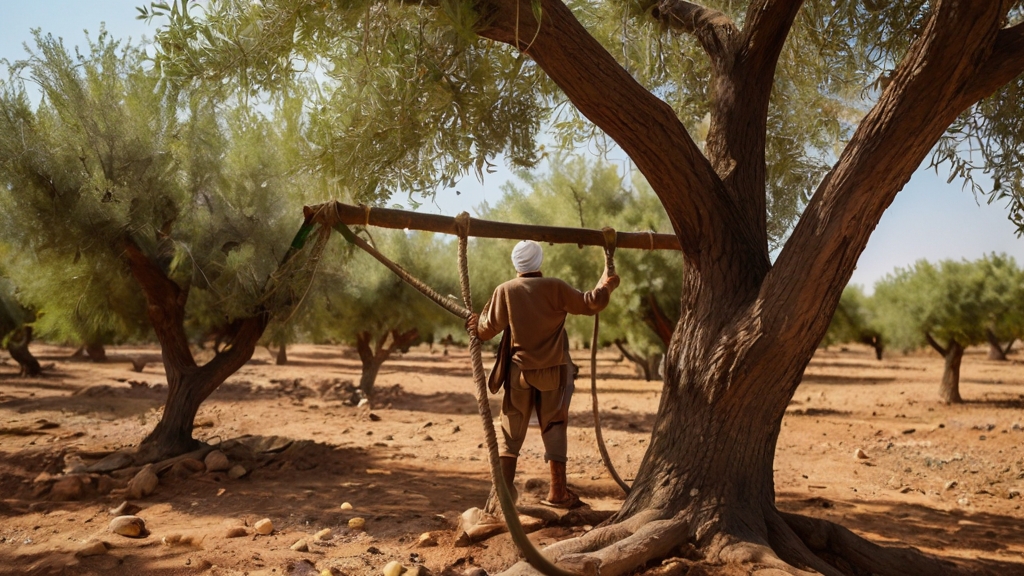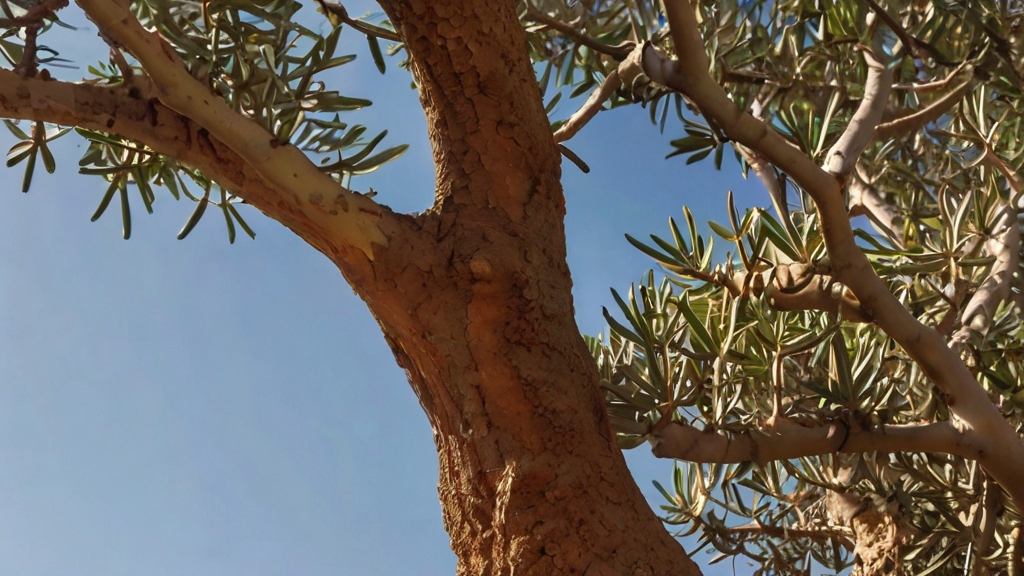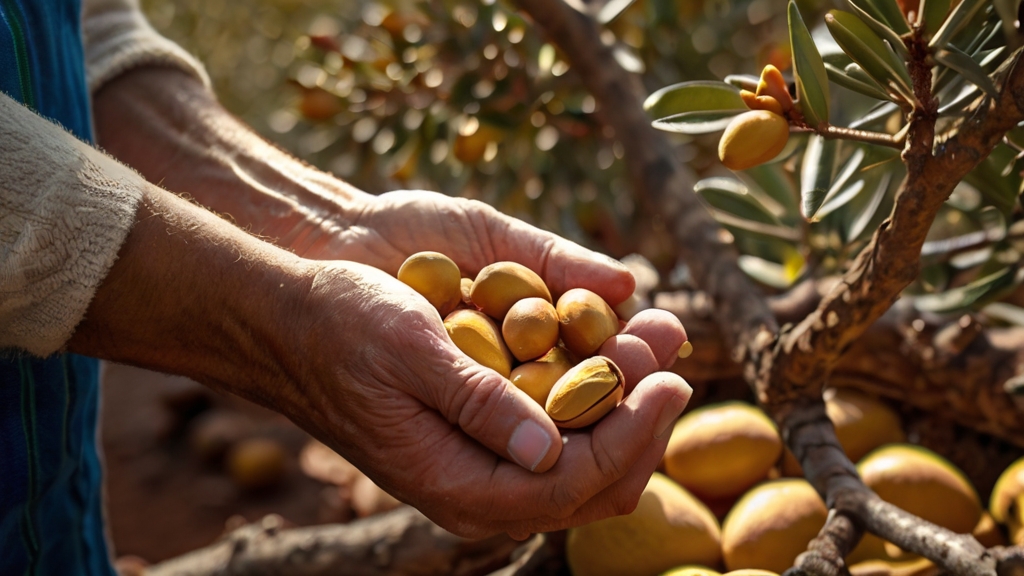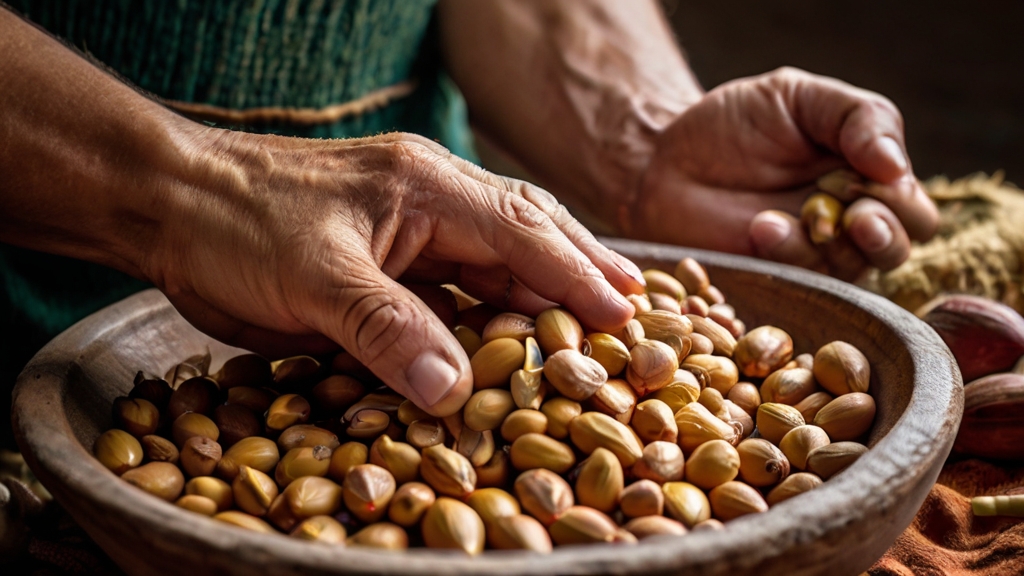
Leila Chaoui
An expert in natural beauty remedies, our author brings a wealth of knowledge and passion for Moroccan Argan Oil, guiding readers on its benefits and versatile uses for radiant skin and hair.
Key Takeaways
Imagine immersing yourself in the intricate artistry of manual Argan oil harvesting techniques. With meticulous precision and timeless traditions, Moroccan women undertake the labor-intensive process of collecting, drying, and extracting the precious kernels that hold the key to this coveted oil. But what makes this ancient practice so captivating? How does the manual approach lend itself to the authenticity and quality of Argan oil? As you delve into the depths of this intriguing discussion, you’ll uncover the remarkable journey from tree to bottle, and gain a newfound appreciation for the dedication and passion that goes into each drop of this liquid gold.
- Climbing Argan Trees: Specialized climbing techniques and traditional methods are used for safe and sustainable harvest.
- Collecting Argan Fruits: Ripe fruits are collected from the ground or tree and dried for preparation.
- Extracting Argan Oil From Kernels: Manual cracking of nuts and cold-pressing techniques are employed for oil extraction.
- Filtering and Storing Procedures: Manual filtering and traditional decantation methods are used for purity and preservation.
Climbing Argan Trees

To successfully harvest argan fruits for oil production, Moroccan women employ specialized climbing techniques to safely reach the branches of the argan trees. Climbing is necessary as the branches of the argan trees are difficult to reach from the ground. These traditional methods of climbing and harvesting contribute to the sustainability and authenticity of argan oil production.
Moroccan women have developed unique techniques for climbing the argan trees, allowing them to navigate the tree’s branches with skill and precision. They use their hands and feet to climb, relying on their agility and experience to ensure their safety. These techniques have been passed down through generations, allowing women to efficiently harvest the ripe fruits needed for high-quality argan oil extraction.
The process of climbing the argan trees requires focus and careful attention to detail. Women carefully select the branches to climb, ensuring they are strong enough to support their weight. They use their hands to grip the branches firmly, maintaining balance and stability as they ascend. By using these traditional methods, Moroccan women are able to reach even the highest branches, where the ripest fruits are often found.
Climbing the argan trees is not only a physical skill but also a testament to the women’s deep connection to the land and their commitment to preserving the authenticity of argan oil production. By hand-harvesting the fruits, they ensure that only the highest-quality argan fruits are collected for oil extraction. This attention to detail and commitment to tradition is what sets Moroccan argan oil apart and makes it highly sought after around the world.
Collecting Argan Fruits

Moroccan women collect ripe Argan fruits either from the ground or directly from the tree during the harvesting season. This crucial step is the first in the labor-intensive process of producing high-quality Argan oil. The collected fruits are then dried in the sun to prepare them for the next stage of extraction.
To provide a deeper understanding of the process, consider the following table:
| Argan Fruits | Collection | Drying | Kernels |
|---|---|---|---|
| Harvested | Manual | Sun | Almond- |
| shaped | |||
| kernels |
The outer part of the Argan fruit, which resembles a thick peel, is utilized as animal feed due to its low oil content. However, the inner nut contains almond-shaped kernels that are rich in oil. These kernels are the primary source of Argan oil.
Traditional Argan oil production involves manual extraction methods, where the collected kernels are ground and kneaded to extract the oil. This meticulous process ensures the authenticity and quality of the oil, preserving its unique properties and benefits.
The collection and drying of Argan fruits require significant labor and attention to detail. This labor-intensive process is necessary to maintain the oil’s excellence and the traditional methods that have been practiced for centuries.
Removing Argan Fruit Pulp

After the Argan fruits are harvested, the next step in the process is to carefully remove the pulp by hand in order to access the valuable kernels inside. This manual separation is a crucial step in the traditional techniques used in Morocco to produce high-quality Argan oil.
The removal of the Argan fruit pulp is a labor-intensive task that requires precision. Women in Morocco, who play a significant role in the Argan oil production, use their skillful hands to delicately separate the pulp from the hard nut. They carefully crack open the fruit to reveal the almond-shaped kernels hidden inside.
The manual separation process is essential to preserve the integrity of the kernels. Any damage to the kernels during this stage could affect the quality and flavor of the resulting oil. Therefore, the removal of the pulp requires great attention to detail and accuracy.
Furthermore, the separated pulp, which is no longer needed for oil extraction, is not wasted. Instead, it is often repurposed as animal feed or used for other purposes to minimize waste in the production process. This waste minimization approach aligns with the sustainable practices followed in Argan oil production.
Extracting Argan Oil From Kernels

The extraction of Argan oil from the kernels involves a labor-intensive process that requires the manual cracking of the hard nuts to access the precious almond-shaped kernels inside. This manual extraction ensures the preservation of the oil’s quality, aroma, and valuable properties.
Here are the steps involved in extracting Argan oil from the kernels:
- Cracking the Nuts: The first step is to crack open the hard nuts of the argan fruit to reveal the kernels inside. This is done manually using traditional methods, as it requires precision and careful handling.
- Obtaining the Kernels: Once the nuts are cracked, the almond-shaped kernels are carefully collected. These kernels are the source of the highly sought-after Argan oil.
- Cold Pressing: After obtaining the kernels, they are cold-pressed to extract the oil. Cold pressing involves crushing the kernels and then applying pressure to extract the oil without using heat. This method helps to retain the oil’s natural properties and ensure its high quality.
- Hand Processes: The entire extraction process, from cracking the nuts to cold pressing the kernels, is carried out using hand processes. This labor-intensive approach is necessary to ensure the best quality oil is obtained.
By following these manual extraction techniques, the valuable properties of Argan oil are preserved, resulting in a high-quality product. The labor-intensive process of extracting the oil from the kernels showcases the dedication and care that goes into producing this precious oil.
In the next subtopic, we will discuss the important steps of filtering and storing the obtained Argan oil to maintain its quality and prolong its shelf life.
Filtering and Storing the Obtained Argan Oil

To ensure the preservation of its raw quality and essential nutrients, Argan oil undergoes a meticulous manual filtering process after extraction. This step is crucial in maintaining the oil’s purity and effectiveness in various applications. The traditional oil decantation method is employed to separate impurities and sediment from the precious oil, resulting in a better quality product.
During the filtering process, hand-pressed Argan oil is carefully poured through a filter made from cotton or fine mesh. This helps remove any remaining impurities, ensuring a clean and pure oil. The filtered oil retains its natural nutty flavor and aroma, making it ideal for culinary uses.
The table below provides a summary of the filtering and storage process for obtained Argan oil:
| Steps | Description |
|---|---|
| Filtering | Hand-pressed Argan oil is carefully poured through a cotton or fine mesh filter. |
| Removal of impurities | The filtering process helps remove impurities and sediment, ensuring a clean and pure oil. |
| Preservation of nutrients | The manual filtering process helps preserve the oil’s essential nutrients and valuable ingredients. |
| Storage | The filtered Argan oil should be stored in dark glass bottles in a cool, dark place. |
| Shelf life extension | Proper storage conditions help maintain the oil’s quality and extend its shelf life. |
Pure Argan oil, obtained through these meticulous filtering techniques, is highly sought after for its numerous benefits. Whether used in culinary dishes or as a beauty treatment, the hand-extracted Argan oil from the Argan kernels grown in the biosphere reserve continues to be cherished for its exceptional quality and valuable properties.
Frequently Asked Questions
How Do You Harvest Argan Oil?
To harvest argan oil, you rely on traditional extraction methods. First, ripe argan fruits are hand-picked from the argan trees. Then, the collected fruits are sun-dried to prepare them for the oil extraction process. The hard nut of the argan fruit contains almond-shaped kernels, from which the oil is extracted. This labor-intensive and traditional process ensures the production of high-quality argan oil. It is widely used in skincare, haircare, cooking, traditional medicine, and as an eco-friendly alternative to other beauty oils.
How Do You Pick Argan Oil?
To pick argan oil, you need to first understand the manual harvesting process. Moroccan women carefully handpick the argan fruit from the trees or ground. These fruits are then dried in the sun before the hard nuts are cracked open to extract the valuable kernels. The kernels are then cold-pressed to produce the precious argan oil. This oil is highly beneficial for hair, skincare, and even traditional Moroccan cuisine. Proper storage is crucial to maintain its quality.
What Are the Steps Involved in Extracting the Oil From the Argan Tree Kernels?
To extract oil from argan tree kernels, you’ll need to follow traditional extraction methods. Start by hand harvesting the ripe argan fruits and cracking open the hard nuts. Then, sun dry the cracked kernels to remove moisture. Next, grind the kernels into a paste and press it to extract the oil. After that, filter and refine the oil to remove impurities. Finally, package and store the argan oil for later use. The importance of these techniques is upheld by local cooperatives, empowering communities and preserving tradition.
How Is Argan Oil Obtained?
To obtain argan oil, you begin by harvesting the ripe fruits of the argan tree. The hard nuts inside the fruits are cracked open by hand, revealing the almond-shaped kernels. These kernels are then cold-pressed to extract the oil. Argan oil has numerous benefits for hair care and can be used as a natural remedy for skin conditions. It holds great cultural significance in Morocco and is widely used in cooking. The manual extraction method ensures maximum purity and quality, preserving the oil’s natural properties.
Related Articles
Traditional Argan Oil Uses by Natives
Discover the astonishing array of traditional Argan oil uses by natives, from culinary delights to medicinal wonders, that will leave you amazed and craving for more.
UV Absorption Rate of Argan Oil
Get ready to uncover the surprising truth about the UV absorption rate of Argan Oil, and how it could revolutionize your sun protection routine.
Berber Argan Oil Production Techniques
Discover the intricate 'P'rocesses behind Berber Argan oil production, and unravel the secrets to its exclusivity, cultural heritage preservation, and high value.


